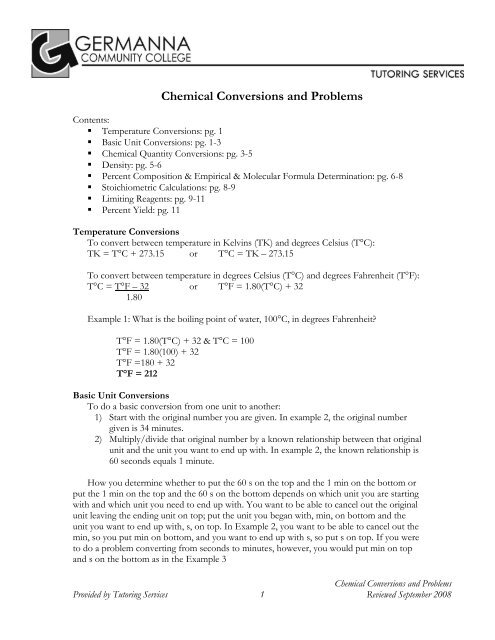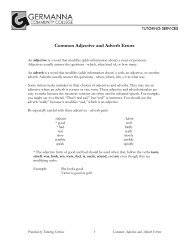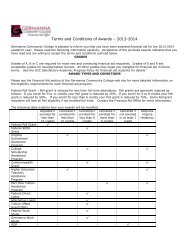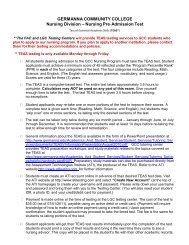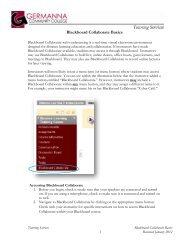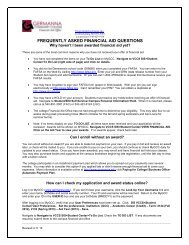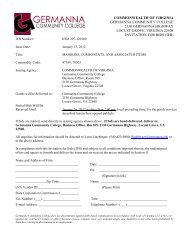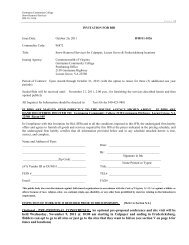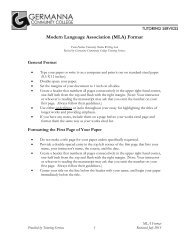Chemical Conversions and Problems - Germanna Community College
Chemical Conversions and Problems - Germanna Community College
Chemical Conversions and Problems - Germanna Community College
You also want an ePaper? Increase the reach of your titles
YUMPU automatically turns print PDFs into web optimized ePapers that Google loves.
<strong>Chemical</strong> <strong>Conversions</strong> <strong>and</strong> <strong>Problems</strong><br />
Contents:<br />
• Temperature <strong>Conversions</strong>: pg. 1<br />
• Basic Unit <strong>Conversions</strong>: pg. 1-3<br />
• <strong>Chemical</strong> Quantity <strong>Conversions</strong>: pg. 3-5<br />
• Density: pg. 5-6<br />
• Percent Composition & Empirical & Molecular Formula Determination: pg. 6-8<br />
• Stoichiometric Calculations: pg. 8-9<br />
• Limiting Reagents: pg. 9-11<br />
• Percent Yield: pg. 11<br />
Temperature <strong>Conversions</strong><br />
To convert between temperature in Kelvins (TK) <strong>and</strong> degrees Celsius (T°C):<br />
TK = T°C + 273.15 or T°C = TK – 273.15<br />
To convert between temperature in degrees Celsius (T°C) <strong>and</strong> degrees Fahrenheit (T°F):<br />
T°C = T°F – 32 or T°F = 1.80(T°C) + 32<br />
1.80<br />
Example 1: What is the boiling point of water, 100°C, in degrees Fahrenheit?<br />
T°F = 1.80(T°C) + 32 & T°C = 100<br />
T°F = 1.80(100) + 32<br />
T°F =180 + 32<br />
T°F = 212<br />
Basic Unit <strong>Conversions</strong><br />
To do a basic conversion from one unit to another:<br />
1) Start with the original number you are given. In example 2, the original number<br />
given is 34 minutes.<br />
2) Multiply/divide that original number by a known relationship between that original<br />
unit <strong>and</strong> the unit you want to end up with. In example 2, the known relationship is<br />
60 seconds equals 1 minute.<br />
How you determine whether to put the 60 s on the top <strong>and</strong> the 1 min on the bottom or<br />
put the 1 min on the top <strong>and</strong> the 60 s on the bottom depends on which unit you are starting<br />
with <strong>and</strong> which unit you need to end up with. You want to be able to cancel out the original<br />
unit leaving the ending unit on top; put the unit you began with, min, on bottom <strong>and</strong> the<br />
unit you want to end up with, s, on top. In Example 2, you want to be able to cancel out the<br />
min, so you put min on bottom, <strong>and</strong> you want to end up with s, so put s on top. If you were<br />
to do a problem converting from seconds to minutes, however, you would put min on top<br />
<strong>and</strong> s on the bottom as in the Example 3<br />
<strong>Chemical</strong> <strong>Conversions</strong> <strong>and</strong> <strong>Problems</strong><br />
Provided by Tutoring Services 1 Reviewed September 2008
Example 2: How many seconds are in 34 minutes?<br />
Example 3: How many minutes are in 25 seconds?<br />
Often in conversion problems, you will have to use more than one conversion factor<br />
(known relationship) as in Example 4. Just take these multi-step conversions one step at<br />
a time, canceling out all units except the one you want to end up with.<br />
Example 4: How many centimeters are in 10 miles?<br />
Known relationships: 1 mi = 5280 ft, 1 ft = 12 in, <strong>and</strong> 1 in = 2.54 cm<br />
(If you need to review how to put numbers in scientific notation, see our<br />
h<strong>and</strong>out Exponents, Radicals, <strong>and</strong> Scientific Notation.)<br />
Another type of common conversion problem deals with conversions between some<br />
unit <strong>and</strong> a prefix of that unit such as a conversion from meters to millimeters. The following<br />
table provides a list of some widely used prefixes. For example, 1 gigameter (Gm) =<br />
1,000,000,000 meters (m) or 10 9 m, <strong>and</strong> 1 microinch (μm) = 0.000001 in or 10 -6 in.<br />
Prefix<br />
Value<br />
Name Symbol Numerical Exponential<br />
giga G 1,000,000,000 10 9<br />
mega M 1,000,000 10 6<br />
kilo k 1,000 10 3<br />
hector h 100 10 2<br />
deka da 10 10 1<br />
deci d 0.1 10 -1<br />
centi c 0.01 10 -2<br />
milli m 0.001 10 -3<br />
micro μ 0.000001 10 -6<br />
nano n 0.000000001 10 -9<br />
pico p 0.000000000001 10 -12<br />
femto f 0.000000000000001 10 -15<br />
Provided by Tutoring Services 2 <strong>Chemical</strong> <strong>Conversions</strong> <strong>and</strong> <strong>Problems</strong>
Example 5: How many picograms are there in 4 hectorgrams?<br />
In the above example, it is possible to do the problem in either two ways. Both are<br />
correct, but the second way is easier since you don’t have to deal with very large <strong>and</strong> very<br />
small numbers. The method you choose to use depends on how comfortable you are with<br />
using terms in scientific notation.<br />
<strong>Chemical</strong> Quantity <strong>Conversions</strong><br />
<strong>Conversions</strong> between different units of chemical quantities are a very important part of<br />
chemistry. The conversions you will encounter the most will be those between grams, moles,<br />
numbers of molecules, <strong>and</strong> numbers of atoms. The mole is a central unit of quantity in<br />
chemistry, <strong>and</strong> it represents the number of atoms in 12 grams of the carbon-12 isotope,<br />
which is 6.022 x 10 23 atoms. This number, which equals 1 mole, is called Avogadro’s<br />
number. You can have a mole of anything, not just atoms. You can have a mole of<br />
molecules or a mole of test tubes or a mole of people. A mole, like a dozen, is a st<strong>and</strong>ard<br />
amount of any object. A conversion between moles of an object <strong>and</strong> the number of that<br />
object can be set up just like the previous unit conversion examples.<br />
Example 6: How many water molecules are there in 6.0 moles of water?<br />
Example 7: How many moles of Na are there if there are 5,900,000 atoms of Na?<br />
<strong>Conversions</strong> between moles <strong>and</strong> grams of a chemical can be done by using molar mass,<br />
which is the addition of the atomic masses of the atoms making up that molecule. Atomic<br />
mass is the mass in grams of 1 mole, 6.022 x 10 23 atoms, of an element. These atomic masses<br />
are listed on most periodic tables.<br />
Provided by Tutoring Services 3 <strong>Chemical</strong> <strong>Conversions</strong> <strong>and</strong> <strong>Problems</strong>
Example 8: What is the molar mass of H 2 SO 4 ?<br />
H: 2(1 g/mol) = 2 g/mol<br />
S: 1(32 g/mol) = 32 g/mol<br />
O: 4(16 g/mol) = 64 g/mol<br />
98 g/mol<br />
In Example 8, H 2 SO 4 was made up of 4 O atoms, so the atomic mass of O was multiplied by<br />
4. Likewise, the atomic masses of H <strong>and</strong> S were multiplied by 2 <strong>and</strong> 1 since there were 2<br />
atoms of H <strong>and</strong> 1 atom of S. Once you have solved for the molar mass of a molecule, you<br />
can use it to convert between moles <strong>and</strong> grams in a conversion problem set up just like basic<br />
unit conversions. This is possible because the molar mass of any compound equals 1 mole of<br />
that compound.<br />
Example 9: How many grams are in 50. moles of H 2 SO 4 ?<br />
Known relationship: 1 mol = the molar mass of H 2 SO 4 = 98 g<br />
Once you know how to convert between moles <strong>and</strong> grams <strong>and</strong> between moles <strong>and</strong><br />
numbers of atoms or molecules, you can perform conversions between grams <strong>and</strong> number<br />
of atoms or molecules by putting together the two known relationships between moles <strong>and</strong><br />
grams <strong>and</strong> between moles <strong>and</strong> number of atoms or molecules.<br />
Example 10: How many kilograms of Ne gas are there if there are 104 atoms of Ne?<br />
Known relationships: 1 mol = 6.022 x 10 23 atoms, 1 mol = molar mass of Ne = 20g,<br />
1 kg = 10 3 g (or 1000 g)<br />
In some problems, you may have to convert between moles or grams of some molecules<br />
<strong>and</strong> atoms of an element in that molecule. For example, you might be given moles or grams<br />
of C 2 H 6 <strong>and</strong> be asked to find the number of H atoms in that sample. In problems like this,<br />
you can use the fact that there are 6 atoms of H in 1 mlcl of C 2 H 6 as a conversion factor.<br />
Example 11: How many atoms of H are there in 124 g of NH 3 ?<br />
Known relationships: 1 mol = molar mass of NH 3 = 17 g, 1 mol = 6.022 x 10 23<br />
mlcls, 1 mlcl NH 3 = 3 atoms H<br />
Provided by Tutoring Services 4 <strong>Chemical</strong> <strong>Conversions</strong> <strong>and</strong> <strong>Problems</strong>
Density<br />
The density of a substance is the ratio of that substance’s mass to its volume. The higher<br />
the density of a substance, the less space it takes to fill that space with some amount of the<br />
substance. For example, imagine you have 100 pounds of lead <strong>and</strong> 100 pounds of cotton<br />
balls. It would take a space with a much larger volume to accommodate 100 pounds of<br />
cotton balls than lead. This is because lead is much denser than cotton balls. To determine<br />
the density of a substance, divide the amount of that substance by the volume it takes to<br />
accommodate that amount. If you know the density, you can solve for the volume a certain<br />
mass will occupy or you can solve for the mass a certain volume will accommodate.<br />
Density = Mass or Volume = Mass or Mass = Volume x Density<br />
Volume<br />
Density<br />
Example 12: What is the density of 908 g of cadmium metal that occupies 105 mL?<br />
Density = Mass = 908 g = 8.65 g/mL<br />
Volume 105 mL<br />
The important thing is to first make sure you are dealing with the correct units before<br />
solving for density. Mass should be in grams, <strong>and</strong> volume should either be in mL or cm 3<br />
since 1 mL = 1 cm 3 . This means density should always be in g/mL or g/cm 3 . You may have<br />
to do some basic unit converting first.<br />
Example 13: What mass of Ne gas with a density of 0.00090 g/mL occupies a volume of<br />
70 ounces?<br />
Known relationships: 32 oz = 1 qt (quart), 1.0567 qt = 1 L, <strong>and</strong> 1 mL = 10 -3 L<br />
(or 0.001 L)<br />
Sometimes density can be incorporated into other types of problems, for example,<br />
chemical quantity conversions. In Example 14, you must find the mass from the density <strong>and</strong><br />
volume before the number of moles can be found.<br />
Example 14: How many moles are there in a sample of titanium metal, density 4.54<br />
g/mL, that can occupy a volume of 25.0 mL?<br />
Known relationships: 1 mol = molar mass of Ti = 48 g<br />
Provided by Tutoring Services 5 <strong>Chemical</strong> <strong>Conversions</strong> <strong>and</strong> <strong>Problems</strong>
Percent Composition & Empirical & Molecular Formula Determination<br />
The molecular formula of a compound is the chemical formula that specifies the number<br />
of atoms of each element in one molecule of that compound <strong>and</strong> specifies the number of<br />
moles of each element in one mole of that compound. The molecular formula for sugar<br />
glucose is C 6 H 12 O 6 . This means that for every 1 molecule of glucose, there are 6 atoms of C,<br />
12 atoms of H, <strong>and</strong> 6 atoms of O. This also means that for every 1 mole of glucose, there<br />
are 6 moles of C, 12 moles of H, <strong>and</strong> 6 moles of O. The empirical formula of a compound is<br />
the smallest whole number ratio of the molecular formula <strong>and</strong> gives the relative number of<br />
atoms of each element in the compound. The empirical formula for glucose is CH 2 O. This<br />
means that the ratio of C, H, <strong>and</strong> O in glucose is 1 : 2 : 1. The percent composition of a<br />
compound gives the percentage of each element in that compound. The percent<br />
composition of K 2 CO 3 , for example, is 56.52% K, 8.70% C, <strong>and</strong> 34.78% O. Knowing<br />
percent composition can help you determine empirical formula, <strong>and</strong> knowing empirical<br />
formula can help you determine molecular formula, so we will go over how to determine<br />
each of these.<br />
To determine the percent composition of a compound:<br />
1) Convert moles of each element into grams.<br />
2) Add the mass in grams of each element to get a total mass.<br />
3) Divide each element’s mass in grams by the total mass in grams <strong>and</strong> multiply by<br />
100%.<br />
4) Check your answer by making sure that the sum of the percentages equals about<br />
100%. The sum may not equal exactly 100% depending on how much you<br />
rounded your answers.<br />
Example 15: What is the percent composition of K 2 CO 3 ?<br />
Provided by Tutoring Services 6 <strong>Chemical</strong> <strong>Conversions</strong> <strong>and</strong> <strong>Problems</strong>
You can find the empirical formula of a compound if you know the percent composition of<br />
that compound. To do so:<br />
1) Designate the total amount of sample as 100 g so that the percentage of each<br />
element will equal the amount in grams of each element.<br />
2) Convert grams of each element into moles.<br />
3) Divide each number of moles by the smallest number of moles. In example 16, the<br />
smallest number of moles is Cr, so moles of K, moles of Cr, <strong>and</strong> moles of O will<br />
each be divided by moles of Cr.<br />
4) Put the numbers obtained from dividing by the smallest number into a ratio.<br />
5) Multiply that ratio by the smallest whole number that will give a ratio of close to<br />
whole numbers.<br />
Example 16: What is the empirical formula of a compound containing 26.57% K,<br />
35.36% Cr, <strong>and</strong> 38.07% O?<br />
The molecular formula of a compound can be determined if you know the empirical<br />
formula <strong>and</strong> the molar mass of the compound. To do so:<br />
1) Convert moles of each element into grams.<br />
2) Add the grams of each element together to get a total empirical formula weight.<br />
3) Divide the molar mass by the empirical formula weight.<br />
4) Multiply the subscripts of each element by the number obtained from step 3.<br />
Example 17: What is the molecular formula of ethylene glycol if its empirical formula is<br />
CH 3 O <strong>and</strong> its molar mass is 62.1 g?<br />
Provided by Tutoring Services 7 <strong>Chemical</strong> <strong>Conversions</strong> <strong>and</strong> <strong>Problems</strong>
Stoichiometric Calculations<br />
Stoichiometric calculations are calculations that involve the relationship between the<br />
quantity of products <strong>and</strong> of reactants of a chemical equation. With a balanced chemical<br />
equation, you can convert between moles of reactants <strong>and</strong> products using the coefficients.<br />
To convert from the amount of one participant in a reaction to another participant in a<br />
reaction:<br />
1) Make sure the reaction given is balanced (for balancing review, see our Balancing<br />
<strong>Chemical</strong> Equations h<strong>and</strong>out).<br />
2) Convert the amount of the compound given to moles if it is not already.<br />
3) Convert to the desired compound by doing a mole to mole ratio using the<br />
coefficients of the two compounds you’re converting between. Treat the mole to<br />
mole ratio like a conversion factor (known relationship) from basic unit conversion<br />
problems. In example 14, 4 mol NH 3 = 3 mol O 2 , 4 mol NH 3 = 2 mol N 2 , 4 mol<br />
NH 3 = 6 mol H 2 O, 3 mol O 2 = 2 mol N 2 , 3 mol O 2 = 6 mol H 2 O, <strong>and</strong> 2 mol N 2 =<br />
6 mol H 2 O are all conversion factors that can be used to convert between<br />
compounds in the reaction 4NH 3 + 3O 2 → 2N 2 + 6H 2 O. Remember to put the<br />
compound you want to end up with on the top <strong>and</strong> the compound you started<br />
with on the bottom of your ratio so that the compound you started with can be<br />
canceled out just like a unit.<br />
4) If the problem asks for the end compound to be in some unit other than moles, do<br />
that conversion.<br />
Example 18: How many moles of H 2 O are produced if 40 moles of NH 3 are used?<br />
Example 19: If 16 grams of O 2 are used in the following reaction, how many grams of<br />
C 2 H 6 are used?<br />
2C 2 H 6 + 7O 2 → 4CO 2 + 6H 2 O<br />
Known relationships: 2 mol C 2 H 6 = 7 mol O 2 , 1 mol = molar mass of C 2 H 6 = 30<br />
g, <strong>and</strong> 1 mol = molar mass of O 2 = 32 g<br />
Provided by Tutoring Services 8 <strong>Chemical</strong> <strong>Conversions</strong> <strong>and</strong> <strong>Problems</strong>
Limiting Reagents<br />
When chemical reactions are performed for industrial purposes, chemical reactants are<br />
often used in specific amounts so that there won’t be any leftover reactants. For instance, in<br />
the following reaction, if you react 5.0 g of Cs with 3.0 g of Br 2 , both reactants will be<br />
completely used up <strong>and</strong> there will be no leftovers of either Cs or Br 2 .<br />
2Cs + Br 2 → 2CsBr<br />
However, if you mix 5.0 g of Cs with 2.5 g of Br 2 , there will be leftover Cs since there wasn’t<br />
enough Br 2 to completely consume the Cs. In this situation, Br 2 is called the limiting reactant<br />
or limiting reagent. Note that Br 2 won’t always be the limiting reagent for this reaction.<br />
Whether Cs or Br 2 or neither is the limiting reagent depends on the amount of each reactant<br />
you begin with. The following steps can help you take a reaction <strong>and</strong> determine which, if<br />
any, reactant is limiting, determine how much of the non-limiting reactant will be leftover,<br />
<strong>and</strong> determine the amount of each product formed.<br />
1) Make sure the given reaction is balanced.<br />
2) Convert the amount of each reactant to moles if they are not in moles already.<br />
3) Start with the given amount of one of the reactants in moles, reactant A, <strong>and</strong><br />
convert to moles of the other reactant, reactant B, using a mole to mole ratio of<br />
the reactants’ coefficients as your conversion factor (see pg. 8 on stoichiometric<br />
calculations for review on mole to mole ratios). This will give you the amount of B<br />
needed to completely consume the A.<br />
4) Compare the actual amount of B you have with the amount you would need to<br />
consume all the A to determine which reactant, if any, is limiting. If the actual<br />
amount of B is less than is needed to consume all the A, B will be limiting. If the<br />
actual amount of B is more than is needed to consume all the A, A will be limiting.<br />
If the actual amount of B equals the amount needed to consume all the A, neither<br />
reactant will be limiting.<br />
5) If reactant A is limiting, you can determine the leftover amount of B by subtracting<br />
the actual amount of B used by the amount of B needed to completely consume A.<br />
If reactant B is limiting, you will first need to determine how much of A is needed<br />
to consume B (see step 3). Next, subtract the actual amount of A used by the<br />
amount that you just calculated (the amount needed to consume B). If neither<br />
reactant is limiting, there will be no leftover of either reactant.<br />
6) To calculate the amount of a product that will be formed, use the amount of<br />
limiting reagent used in moles to convert to moles of that product using a mole to<br />
mole ratio.<br />
7) If the problem asks for the product to be in a unit besides moles, or if the reactant<br />
amounts are given in a unit besides moles, convert the products to that unit.<br />
Provided by Tutoring Services 9 <strong>Chemical</strong> <strong>Conversions</strong> <strong>and</strong> <strong>Problems</strong>
Example 20: A solution containing 2.00 g of C 5 H 11 OH was added to a solution<br />
containing 2.00 g of O 2 . Which reagent is the limiting reagent? How much<br />
of the reagent that is not limiting will be left over?<br />
Since the amount of C 5 H 11 OH that will react with all the O 2 , 1.67 x 10 -2 mol is<br />
less than the amount of C 5 H 11 OH actually used, 2.27 x 10 -2 mol, there will be<br />
leftover C 5 H 11 OH, <strong>and</strong> O 2 will be the limiting reagent. This could also be<br />
determined if you determined how much O 2 would be needed to react with all<br />
the C 5 H 11 OH. That amount would be more than the available amount of O 2 .<br />
Since O 2 is the limiting reagent, all of it will be consumed, <strong>and</strong> there will be<br />
leftover C 5 H 11 OH.<br />
Example 21: How many grams of Ca 3 (PO 4 ) 2 <strong>and</strong> grams of KCl can be produced by<br />
mixing 5.00 g of CaCl 2 with 8.00 g of K 3 PO 4 ?<br />
3CaCl 2 + 2 K 3 PO 4 → Ca 3 (PO 4 ) 2 + 6KCl<br />
Provided by Tutoring Services 10 <strong>Chemical</strong> <strong>Conversions</strong> <strong>and</strong> <strong>Problems</strong>
CaCl 2 is the limiting reagent since there is not enough of it for all the K 3 PO 4<br />
being used to be consumed. 0.0566 mol CaCl 2 would be needed for all the K 3 PO 4<br />
to be consumed, but we only have 0.0455 mol CaCl 2 .<br />
Percent Yield<br />
The theoretical yield of a reaction is the amount of product that was calculated to be<br />
produced. Example 21 shows how to calculate the theoretical yield of a product or products.<br />
Percent yield is the percentage of the theoretical yield that was actually obtained when the<br />
chemical reaction was performed. To calculate the percent yield, use the following formula:<br />
Percent Yield = Actual Yield x 100%<br />
Theoretical Yield<br />
Example 22: The theoretical yield of H 2 O in the combustion of CH 4 was calculated to be<br />
55 g, but when the reaction was actually performed, the amount of H 2 O yielded was 51.7 g.<br />
What is the percent yield?<br />
Percent Yield = Actual Yield x 100%<br />
Theoretical Yield<br />
Provided by Tutoring Services 11 <strong>Chemical</strong> <strong>Conversions</strong> <strong>and</strong> <strong>Problems</strong>
*If you found this h<strong>and</strong>out helpful, try the Tutoring Center’s other chemistry<br />
h<strong>and</strong>outs! Pick one up outside either of our campus’ offices or print them out from<br />
http://www.germanna.edu/Academics_And_Student_Services/Student_Services/T<br />
utoring_Services/helpful-h<strong>and</strong>outs.asp.*<br />
Periodic Table – Gives a traditional periodic table with atomic masses <strong>and</strong> atomic<br />
numbers with additional trends <strong>and</strong> values such as electronegativity <strong>and</strong> ionization<br />
energy in one convenient h<strong>and</strong>out. This h<strong>and</strong>out is available in color <strong>and</strong> in<br />
black/white, but the color table is suggested since it is easier to read.<br />
Balancing <strong>Chemical</strong> Equations – Gives step-by-step instructions on how to balance<br />
chemical equations <strong>and</strong> contains many practice problems to help you perfect your<br />
balancing.<br />
Naming Compounds – Gives step-by-step instructions on how to name ionic<br />
compounds, binary molecular compounds, <strong>and</strong> acids with practice problems.<br />
Aqueous Reactions – Explains the following types of aqueous reactions: precipitation,<br />
acid/base (neutralization) , <strong>and</strong> oxidation/reduction. Also gives helpful examples <strong>and</strong><br />
practice problems.<br />
Significant Figure Rules – Explains the rules of determining significant figures <strong>and</strong> how<br />
to use these rules in addition, subtraction, multiplication, division, <strong>and</strong> converting.<br />
Also has practice problems.<br />
Exponents, Radicals, <strong>and</strong> Scientific Notation – Under the math h<strong>and</strong>out section, this<br />
h<strong>and</strong>out includes how to turn a number into scientific notation <strong>and</strong> vice versa with<br />
practice problems.<br />
* Information for this h<strong>and</strong>out was obtained from the following sources:<br />
Brown, LeMay, & Bursten. Chemistry: The Central Science. 9 th Ed. Pearson Education, Inc. 2003.<br />
Gilbert, Kriss, & Davies. Chemistry: The Science in Context. 1 st Ed. W. W. Norton & Company. 2004.<br />
Rosenberg & Epstein. Schaum’s Outlines: <strong>College</strong> Chemistry. 8 th Ed. McGraw-Hill. 19<br />
Provided by Tutoring Services 12 <strong>Chemical</strong> <strong>Conversions</strong> <strong>and</strong> <strong>Problems</strong>


